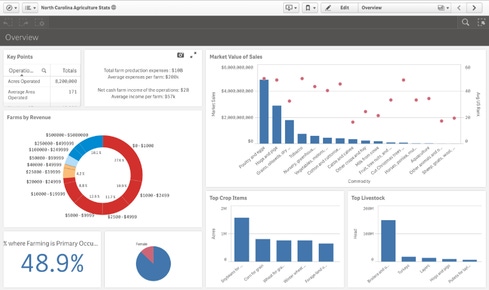As analytics-based technologies mature they promise to better guide executive decisions by delivering only the most relevant information.

We stand at a turning point in the presentation and consumption of data and information. As the volume of available data doubles every three years, human beings cannot expect to keep pace. To ingest and process all that additional information, senior leaders need new tools and assistance to make sense of it all – or they will choose, of necessity, to ignore it, even at the risk of imperiling their organizations.
Today, through novel integrations of data science and augmented/artificial intelligence (A2I), we stand at the dawn of a new era, one in which leaders can expect to have the tools in hand to achieve true data-informed decision making without suffering from information overload.
Data and decisions
For two-decades, data analysts have pushed the idea of “data-driven decision making”; the idea that perfect data can yield perfect understanding to expose clear and logical decisions. This goal has been relentlessly pursued through the perfection of data, yet the net effect of untold hours invested in “cleaning up the data” has fallen short of the promise. Leaders focus on a few numbers they trust and believe and ignore the rest. This disconnect, however, is not the result of technical flaws; rather it is a human problem. All the work that goes into improving the data fails to consider how that information is used by senior business, government, and military leaders to make decisions.
Today, we understand that "thin slicing," as introduced by Malcom Gladwell, enables us to draw broad conclusions from comparatively small data sets. By applying that understanding, we can fuse decision science (how the brain makes decisions), with data science (how we extract meaning from data), business intelligence (the application of data science to business analytics) and A2I to provide business leaders with something more than has ever before been possible. That is an intelligent partner in the decision-making process. In short, technology created the problem of information overload, but it is now also the solution.
Augmented and artificial intelligence in strategic decision making
The difference between augmented and artificial intelligence is that artificial intelligence attempts to replace human decision-making with a machine, while augmented intelligence seeks to empower the decision-maker by providing an intelligent helping hand. While augmented intelligence can recommend courses of action, it more often seeks to increase the precision of the data presented to the human decision maker. Using data and decision science, A2I can enable decision makers to seamlessly interact with far more relevant data as they work through the decision process.
Through automation and enhanced information presentation, decision makers can more rapidly make sense of a wealth of information at their fingertips, delving deep whenever or wherever they feel the need. ADG Creative, a creative communication agency in Columbia, Md., is pioneering ways to reduce extraneous cognitive overload through fully dynamic pull and push interfaces, reducing clutter on dash boards, and using color and other graphic indicators to help users more rapidly understand the picture in front of them. They also link chat bots through cloud structures to enable natural language processing to trigger artificial intelligence and novel algorithms to refine what is delivered – and when – to senior decision makers, based on their preferences, decision and operational priorities and relevancy.
ADG’s efforts organize data elements, use location, color, size and other devices to elevate importance in presentation, employ linear visual analytics to enhance understanding and apply positioning to “prime” executives with appropriate information prior to decision meetings. Research has proven that executives reach better decisions when appropriately primed with relevant information ahead of time; using A2I, therefore, executives can be primed automatically in anticipation of specific discussions.
Proprietary and big data
Of course, design and presentation only matter if the data that’s presented is truly valuable. A core tenet of deriving increased value from data is the linking of multiple datasets. Through linking and correlation, we can make sense of otherwise disparate facts to better inform our decision making without extraneous cognitive overload.
To this end, innovative new companies are emerging that will pave the way to better decisions in the future. Mesur-io is one of those firms. Founded on the belief that data-informed decisions about water use could save institutions money and resources by better monitoring conditions in real time, Mesur-io built the most effective sensors on the market and combined them with a cloud architecture and next-generation business intelligence software from Qlik to provide precision insights on when to water crops, golf courses, campus landscapes and more. Their dashboards, accessible from virtually any device, are as elegant and simple as the customer requests them to be, and enable rapid, simple decision making while avoiding cognitive overload.

Mesur.io dashboard
While automation can help reduce the volume of data that leaders see, by itself it is not enough to build trust and confidence in the data or to derive the right information to make well-informed decisions. By combining the latest advances in machine learning, data analytics and natural language processing, along with cutting edge UI/UX design and powerful cloud-based artificial neural net processors, we stand at the dawn of a new era. Rather than science fiction, each of these technologies are now affordable and accessible. Through novel combinations of these technologies, true data-informed decision making is no longer just an aspirational goal. It is, rather, the art of the possible.

Martin Trevino
Dr. Marty Trevino Jr. is a recognized expert in Analytics and Augmented Intelligence within the US Intelligence Community and major consulting firms. Over his 25-year career, Dr. Trevino has worked in a top-tier consulting capacity and served as a senior Technical Director and Strategist for the National Security Agency (NSA). Dr. Trevino holds multiple university degrees including a Bachelors of Business Administration (BBA), a hybrid Master of Science and the Arts in Military History / International Political Development, and a Doctoral degree of Business Intelligence / Analytics.
During his 25-year career, Dr. Trevino has led global scale Business Intelligence and Analytic efforts, as well as authoring Information Assurance and Analytic strategies for the US Government. Today, Dr. Trevino’s work focuses on the use of Big Data, Visual Analytics and Augmented / Artificial Intelligence to improve strategic decision making. Dr. Trevino is also a professor at the National Defense University where he instructs nation state and military leaders on topics within the realms of Cyber, Big Data and Analytics. Dr. Trevino is currently the Chief Data & Analytics Officer for Red Alpha Consulting of Maryland (http://www.red-alpha.com). He may be reached at [email protected].
About the Author(s)
You May Also Like





